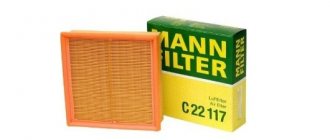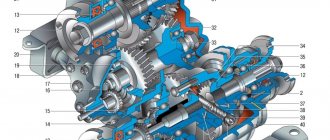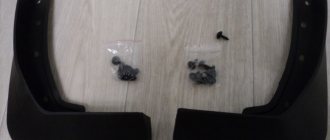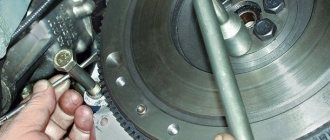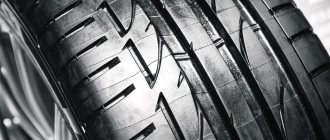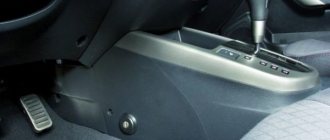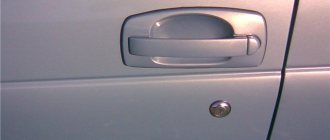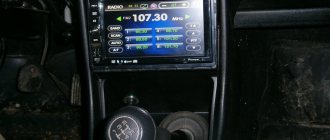Tire rotation direction
If the car pulls to the side when driving and the tires quickly wear out, why could this be?
Have you made repeated wheel alignments, but the problem does not go away? This may mean that the tires are not installed correctly.
Before installing the tires, it is necessary to determine the direction of the tire, because almost every tire has a unique tread pattern that fully reveals itself only when installed correctly.
How to change a tire on a car yourself?
How to change a tire? For the majority of the male population, this question is so simple that it is not even discussed. But what if you damage a tire while traveling and there is no man nearby? You can call technical assistance, or still try to solve the problem without the help of others. Let's find out in practice whether it is difficult to change a tire with gentle women's hands?
It turned out to be completely easy. You don't need to put in a lot of effort to lift the machine. There is also no need to carry wheels. The most difficult thing on some cars is to find a jack and a set of tools. Dear car ladies, we bring to your attention a step-by-step summary of how to change a tire.
To replace a damaged wheel we will need:
- Wheel chocks or a pair of bricks;
- Jack;
- Wheel key;
- Piece of pipe;
- Gloves;
- Some clothes to avoid getting dirty;
- Spare wheel.
Replacement scheme
Previously, it was believed that wheels had to be installed in a certain order. That is, during the season there should be one arrangement, and at the next “change of shoes” - another. All this had one goal - to ensure uniform wear on all elements of the kit. Now this remains relevant only for non-directional asymmetrical models, which can be placed in any way. Let's look at an image with an approximate shift diagram:
Please note: with correct wheel alignment, tire wear will occur evenly, and the indicated diagram will not be useful to you.
Seasonality of tires and rules for their installation
The marking of modern tires usually contains information about the seasonality of use, namely:
- The designations “M+S” or “M&S” are applied to both winter and all-season, as well as summer off-road tires. This marking allows driving on off-road, mud, wet snow, etc. If there is an image of a snowflake next to the abbreviation, then the tires belong to the “winter” category.
- For all-season tires, the marking options “All SEASON”, “ROAD+WINTER”, “ANY Weather”, etc. can be used.
- The inscriptions “WATER”, “RAID”, “AQUA”, “Aquacontact” designate the so-called “rain tires”, which provide improved contact of the treads with wet asphalt.
- Winter tires are identified by the word “Winter” or a logo with a snowflake.
When installing new tires on a car or seasonally replacing tires, you must pay attention to the markings and direction of the wheel tread. When installing a tire with a symmetrically directed pattern, the arrow printed on the sidewall of the tire is positioned in accordance with the direction of rotation of the wheel when the vehicle moves forward.
When installing a tire with a symmetrically directed pattern, the arrow printed on the sidewall of the tire is positioned in accordance with the direction of rotation of the wheel when the vehicle moves forward.
Tires with an asymmetrical pattern must be installed so that the “Outside” designation on the side surface is on the outside of the wheel.
Important! Particular attention is required when installing asymmetrical tires marked “Right” and “Left”. To do this, you will need two pairs of tires with appropriate inscriptions, which are installed on different sides of the car.
Rotation
Tire rotation direction
Some tires (for example, Bridgestone) can be swapped. This is done only crosswise. This means that it is possible to drive 45-60 thousand kilometers, and after that change the location of the wheels. It is possible to put a front left one in place of the right rear one, and a front right one in place of the left rear one. This can be done with the front wheels, but in a strictly defined order.
If the direction of tire movement is specified, the wheels are rearranged on one side, i.e. Front tires are swapped for rear tires and vice versa.
Remaining tire tread depth
Car tires that have a certain mileage have an important value (technical characteristic) called the remaining tread depth. It is easy to guess that it shows the degree of tire wear and indicates the possibility of further use. In the absence of special tire wear indicators, the residual height (depth) of the tread pattern should not be lower than the following permissible values:
- for motorcycles (category L) – 0.8 mm;
- for trucks and trailers (categories O3, O4, N2, N3) – 1 mm;
- for cars and trailers, as well as vehicles with a maximum weight of up to 3.5 tons (categories O1, O2, M1, N1) – 1.6 mm;
- for buses (number of seats more than 8, categories M2, M3) – 2 mm.
The residual depth for winter tires with different tread patterns when used on certain types of road surfaces should be no more than
4 mm. These tires are designed for driving on snowy and icy roads. They are marked with large Latin letters “M” and “S”, and also have a drawing of a mountain peak with a snowflake located inside.
Permissible tread depth for winter tires
Increased demands are placed on winter tires (unlike summer tires, since the quality and height of the tread pattern determines the quality of ride, braking on snowy or icy roads, as well as the safety of the driver and crew members).
The new winter tire has deeper grooves and sipes on the tread, which ensures maximum grip on the road surface and removal of slush from the contact patch. There are three types of tires for driving in the cold season:
- studded;
- friction;
- "Scandinavian".
The first type of winter tires is designed for driving on ice and snow. The studs on the tire break them up, thereby providing good grip on the road surface.
Please note that when passing through asphalt areas, a fairly large background noise is created. It is not recommended to brake sharply, as this can deform the rubber and damage the studs.
Friction tires are designed for driving on slush, mud and shallow snow. Compared to summer tires, the tread height of winter tires should be at least 3 mm higher. Friction rubber has a large number of narrow slots, as well as specially shaped lugs, which significantly increase the stability of the machine on wet road surfaces. All tires of this type are required to be equipped with a symmetrical pattern.
As for “Scandinavian” tires, this type of tire is designed for driving in sub-zero temperatures and heavy snowfall. The tread depth of such tires must be at least 8 mm. “Scandinavian” tires are equipped with an asymmetrical pattern, where wide cups with lamellas are clearly visible, which are necessary for effective action on snow and ice, as well as their removal from the contact area.
Permissible tread depth for summer tires
The tread depth of summer tires directly affects the quality of wheel adhesion to the road surface and promotes water drainage from the contact zone, so its size ranges from 6-8 mm
Please note that the acceptable wear level should not be less than half the original tread height. The minimum tread depth at which tires are allowed to be used must be at least 1.6 mm
In order for summer tires to be used, a prerequisite is the presence of a clearly defined tread pattern, otherwise traction and water drainage will significantly deteriorate (the aquaplaning effect will increase). On new tires, the depth size may vary depending on the type of vehicle. For example, on sports and racing cars, the tire tread height can be 12-17 mm, while on SUVs this figure can be higher.
Video.
21.12.2017 01:00
Winter tires are tires designed specifically for vehicle operation in weather conditions when the air temperature is below +7 C. There are quite a few differences from summer tires, and they are very influential. Driving on summer tires in winter is a risk to your car and your health.
At the end of autumn or early spring, many motorists go to a tire shop or service station to have their cars fitted with the correct tires. While you drink coffee or tea, the technicians will bring the car into proper condition. After this, you need to check whether they did everything correctly! You may ask, how can you incorrectly change your car to winter tires? Yes, simply, for example, the direction of the tread is mixed up.
Types of Tread Patterns
The non-directional symmetrical arrangement of tread blocks is in consistently high demand among motorists who prefer tires in the inexpensive price category. In addition, a large number of new cars have tires of this type as standard. The popularity of this type of tread is explained by the fact that this pattern is considered universal. Advantages of tires with tread blocks placed in a symmetrical, non-directional pattern:
- do not create unnecessary noise while the vehicle is moving;
- allow you to comfortably drive the car at low and fairly high speeds;
- They are distinguished by moderate cost, combined with fairly high-quality performance.
The absence of restrictions in the direction of rotation is an additional advantage of such tires. Thanks to this, during the installation process you don’t have to worry about the rubber being installed on the wrong side. A vehicle with such treads on its wheels will be well controlled when driving on dry or slightly wet asphalt surfaces or on hard dirt surfaces.
When driving a vehicle with symmetrical non-directional tread, be careful when driving on wet roads.
The symmetrical directional pattern of the tread blocks was designed to make the movement of vehicles on wet roads as comfortable and safe as possible. Increased resistance to aquaplaning is achieved due to the presence of drainage grooves arranged in a herringbone shape. Tires with this tread pattern must be installed on the wheels with special care. An incorrectly installed tire will not rotate in the intended direction, as a result of which the rubber will not be able to fully demonstrate its positive driving qualities. Correctly mounting tires with symmetrical directional tread is quite simple, because... There are special inscriptions on their sides that make it easy to distinguish the outer side from the inner side. It should be noted that good directional stability at high speeds can only be achieved on an asphalt surface. Dirt roads quickly clog the tread pattern, exposing your vehicle to dangers such as sliding or skidding.
Tires with asymmetric tread blocks are leaders in vehicle handling tests. Their distinctive feature is the division of the tread pattern into internal and external parts. The inner tread blocks are designed to interact with wet road surfaces, while the outer blocks are designed for dry and unstable road surfaces. Thanks to this solution, tires with asymmetric tread outperform competitors in many technical characteristics
An asymmetrical pattern can be either directional or non-directional, with non-directional being much more common. When installing tires with an asymmetrically located tread, you must pay attention to the markings that allow you to distinguish the inside from the outside, and install the tires correctly
It’s not often that you come across tires that have both a directional and asymmetrical pattern at the same time. The advantage of such rubber is the combination of the above-described qualities of directional and asymmetric treads. Installation of such tires is carried out taking into account the markings applied by the manufacturer.
An unexpected situation may occur on the road, as a result of which you will have to continue your journey with an incorrectly installed wheel. In this case, the speed limit should not exceed 70 - 80 km/h, and the tires should be replaced as soon as possible.
Design Features
The structural features of rubber are distinctive features that increase the driving characteristics of the vehicle.
It is important to understand them for the correct choice of replacement tires
Tubeless, in case of a puncture they retain elasticity for a long time. The rubber tightens around the stuck object. Does not overheat when moving, due to heat removal by the open (metal) part of the rim. In contrast to the tube type, there are increased requirements for the rims, the need to apply additional sealant at the junction of the rim and rubber, and the complexity of installation. Tubeless ones are used more often; if mounted correctly, they have high wear resistance.
The difference between bias-ply and radial tires can only be correctly determined by the markings. Radial - r. Diagonal - do not have a letter index. You can understand the markings of diagonal ones by the presence of the TT designation - operation with a camera. Those who value speed need to understand the differences.
The tread on the tires provides traction. You can determine by the tread:
- seasonal purpose of rubber - for example, it is correct to install tires with metal studs for the winter in a climate zone with frequent thaws and ice;
- in which direction should the tire move (if there are no markings on the rubber, you can determine the side with an asymmetrical pattern by its rigidity - the outer side is stiffer, the correct way to install the tires).
The tread pattern on asymmetrical ones is larger on the outside. Do not purchase with even the slightest difference in the pattern - tires rotate with minimal lag - uneven grip on the road surface
Especially important for highways and sharp descents
How to properly install tires with asymmetric tread pattern
Directional tires can only be mounted in one position on a machine. This is argued by the unique structure of the tread. However, some users are not aware that there are rules for installing asymmetrical tires.
This type of design can operate in both directions without significant impact on driving performance. However, some tires require side alignment. Products with solid tracks must be installed with the monolithic part facing outwards - this improves control stability and traction in corners.
The peculiarity is caused by different rigidity. The inner side is soft, the outer side is made harder to hold the car on turns and improve directional stability.
Bottom line
The outside and inside marks are used to indicate which side of the asymmetrical tire should face outward and which side should face inward of the vehicle.
Even at the dawn of the automotive industry, when car tires were made of natural rubber, which melted in the sun and hardened by frost, designers and manufacturers were thinking about something more perfect. After all, such tires are not far from the wheel on a horse-drawn cart. As a result, technologies developed, oil processing methods improved, and times changed. In 1927, by the way, the Soviet scientist Sergei Vasilyevich Lebedev produced synthetic rubber, which became the progenitor of the material of modern tires. But such a material did not become a panacea; in addition to the rubber itself, which provides high performance properties for tires, the shapes and profiles of the tire were also important. Subsequently, tire treads became flat in order to provide a larger area with the road, and therefore stability on the road. In addition, a protector appeared on them. Moreover, in some cases, the tire tread required a certain installation of the tires, according to their rotation. It is these very installation cases, as well as what will happen if the tires are installed incorrectly, that we will talk about in our article.
How to correctly install a wheel on a car according to the tread pattern
1. What kind of pattern does a car tire tread have?
It doesn’t matter whether the tires are winter or summer, depending on the tread pattern they are divided into three types:
- Non-directional.
- Directional symmetrical.
- Directional asymmetrical.
The principle by which such tires are installed will differ. To understand how to properly position the wheels, you should study the markings on the side of the tire or carefully look at the tread pattern.
The pattern of such tires may look different. There will be no marks on the tires indicating how to properly position the wheels. Therefore, you can install them arbitrarily.
How to properly install wheels with a symmetrical tread pattern?
The pattern is usually made in a V-shape, there is a marking on the side of the tire
To understand how to correctly install such wheels, you need to pay attention to the inscription “ROTATION” and the arrow that indicates the direction of rotation of the wheel. How to correctly install wheels with a directional asymmetric tread pattern?
How to properly install wheels with a directional asymmetric tread pattern?
For such tires, the tread pattern will be different on different sides of the working surface. There is a special marking made in the form of the inscriptions “Outside” on the outside of the tire, and “Inside” on the inner side part.
In addition, such tires may be labeled differently. For example, you can see the inscriptions “Right” and “Left” on the outer sides of tires. By studying these marks, you can understand how to position the wheels correctly: on the left or on the right.
2. How to properly install wheels depending on seasonality?
Car tires are marked so that the marks indicate the season when they can be used. Let's take a closer look:
- The inscriptions “M+S” or “M&S” can be seen not only on tires intended for winter, but also on all-season and summer off-road tires. These designations indicate that the tires are designed for off-road driving, mud and wet snow. When there is a * (snowflake) symbol next to the inscription, it means that the tires can be used in winter.
- If the tires are all-season, then you can see the markings “All SEASON”, “ROAD+WINTER” or “ANY Weather”.
- The words “WATER”, “RAID”, “AQUA”, “Aquacontact” can be seen on tires that provide maximum contact with the road surface. This means that you have rain tires in front of you.
- Tires for winter are marked in a special way. On them you will see the inscription “Winter” or the symbol * (snowflake).
To correctly position the wheels, you should carefully study the inscriptions and marks indicating the direction of the tread pattern.
If the tire has a symmetrical pattern, you will see an arrow on the side of the tire. How to install the tire correctly? The arrow should indicate the direction of rotation when the car starts moving forward.
How to properly install wheels if the tread pattern is asymmetrical? You need to focus on the inscription “Outside”, it should be located on the side of the tire.
Please note: you must be extremely careful when installing tires with an asymmetric tread pattern. Such wheels will have the inscriptions “Right” and “Left”
You will need 2 pairs of tires with this marking. To place the tires correctly, you need to place them on different sides of the car.
3. What happens if the wheels are placed incorrectly or placed randomly?
When the tread pattern is directional, it means that dirt and wet snow will be most effectively removed from the contact patch between the tire and the road surface. As a result, the risk of hydroplaning will be reduced and the car will handle better.
However, if the wheels are not placed correctly, but in a random order, the effect will be exactly the opposite. And if the car drives on wet asphalt, the risk of aquaplaning will increase, and the contact between the tire's working spot and the road will worsen. All this will lead to the car losing directional stability and handling poorly. As a result, an accident may occur.
4. How to install directional wheels correctly?
If you have extensive experience in operating a car, you can install the tires correctly yourself. However, when this operation is performed by technicians at a tire station, you should double-check whether they have positioned the wheels correctly.
Also, we must not forget that if the tires have been re-mounted by a mechanic, they should be balanced on a machine. Otherwise, the wheel will start to hit while driving. This problem most often occurs at high speed.
Once the tires are installed correctly, a pressure check should be performed. If necessary, the tires must be inflated. Otherwise, they will not work effectively while driving.
Introduction
Models with asymmetric tread patterns are becoming more common. It looks quite stylish and aggressive. Does this design have a useful meaning or is it just another marketing ploy? In the article we will find out what an asymmetrical tread pattern means, analyze its useful qualities, and also tell you how to install such tires on a car.
Asymmetric tires, advantages and disadvantages
Tire manufacturers have developed asymmetric tires. Design features, as well as the tread pattern, provide this type of tire with good wheel grip on the road surface. Our article describes the advantages and disadvantages of such tires and indicates the features of its installation.
Design features
Different types of tread patterns The term asymmetrical tires must be understood as tires that differ in the direction of the pattern on the outer as well as the inner side of the treadmill. The first company to introduce the production of this type of rubber was the well-known Nokian brand, which produced tires with a directional tread pattern. Features of these tires:
- You can install tires in accordance with the direction of the arrow or the inscription “ROTATION” on the side of the tire;
- Tires are divided into left and right, marked respectively with the letters L or R.
When installing directional asymmetrical rubber, the following difficulties arose:
- It was almost impossible to install two wheels with left markings or two products with right markings, since tires with left and right markings were rarely available in one car shop.
- Determining the type of tire for a spare tire is quite difficult: it is impossible to know in advance which wheel will require replacement. In force majeure situations, drivers installed the spare wheel on the wrong side, which led to accelerated wear of the tread layer.
Tire manufacturers decided to abandon the production of asymmetric tires with a directional pattern. They were replaced by similar rubber with a non-directional tread pattern.
Non-directional asymmetric tires can be identified by the following characteristics:
- In this type of rubber, the inner side is softer than the outer. This allows you to correctly distribute the load when the car enters a turn: most of the load falls on the outer part of the product.
- The tread blocks on the outside of the tire are larger than on the inside. This design of the tread layer allows for better drainage of fluid from the grip patch of the wheels and the road surface. This reduces the risk of hydroplaning and makes driving easier.
- Car tires are installed on the left and right sides.
On symmetrical tires there is no marking on the outer and inner sides; by this feature it is easy to distinguish symmetrical tires from asymmetrical products.
We recommend watching a video about directional and asymmetrical tires:
Advantages and disadvantages, installation features
Advantages of tires with an asymmetric tread layer:
Disadvantages: significant disadvantages were present in asymmetric tires with a directional tread pattern, but this type of tire has been discontinued.
Installation of rubber with an asymmetrical tread pattern is carried out taking into account the outer and inner sides of the product. You can find out which side to mount the tires by looking at the corresponding inscription on the side of the tire. Their outer side has one of the designations:
- outside;
- side facing forwards;
- external.
The inside of the tire has one of the markings:
- this side facing inwards;
- inside.
When installing such tires, the direction of the tread pattern does not matter. Correct installation involves placing tires depending on the outside and inside of the tire.
Conclusion
Asymmetric tires are often confused with directional tires - this causes difficulties in installing these products on a car. We have indicated the distinctive characteristics and design features of tires with an asymmetrical tread pattern, which must be taken into account when purchasing and installing this type of rubber.
Purchasing tires with an asymmetric tread pattern is important when purchasing expensive tires; such a tread pattern ensures a long service life of the rubber.
pro-zamenu.ru
Installation
Installing Bridgestone asymmetric tires does not require highly skilled skills if you remember a few instructions. The inscriptions “Inside” and “Outside” must be strictly established according to the rules.
Directional tires must be installed so that when driving, the wheel moves in the direction indicated by the arrow. When installing, you need to focus on moving forward.
Symmetrical (non-directional) tires are installed at the discretion of the owner. Therefore, they do not have any instructions for installation.
Important: if at least one wheel is installed incorrectly, then vehicle control will deteriorate sharply, and the tires will quickly become unusable!
Installation is best done as follows:
- Loosen the mounting bolts. To raise
car, you need a jack and a flat surface. After which the old wheels are removed and new wheels are installed.
To avoid confusion during the installation process, it is recommended to change one tire at a time. It is better to immediately install new tires in place of old ones. When installing, you must strictly follow the instructions and monitor the direction of the new tires. Competent and correct installation ensures that the vehicle's driving performance will be excellent, and you will not have to buy new tires every month.
Proper installation of summer, winter or all-season tires guarantees that the tires will maximize their driving performance, and car owners will be able to feel comfortable and safe at any time of the year, and on any road surface.
Source kolesnyigid.ru
I think any motorist who changed his own wheels for the first time had the following question: “Which wheel should I put where?” Of course, I won’t tell experienced drivers anything new, but many beginners read me and I think this information will be interesting for them. This is what today’s article will be about, especially since it is more relevant than ever, because... The time for “re-shoeing” has already begun.
Right or left?
This is the most common question among those drivers who are changing tires for the first time. In general, to answer this question you just need to look carefully at your “tires” - everything is written on it. The main thing is to understand the markings and understand what type of tires you have.
So, 3 types of tires are now widely used:
- Non-directional
- Directed
- Asymmetrical
How do you know what type you have?
So, the most basic way is to just look carefully at the sidewalls of the tires.
- If the tires have the inscription “Ins>That is, as you understand, you just need to carefully examine the tires - everything is written on them. No special knowledge required.
Now let's figure out which axle to put the wheels on - forward or backward?
In general, there is nothing complicated here either. There are two cases: when you have new tires and when you have used ones. If the tires are new, then in fact there is no difference where you put the wheels (forward or backward) - i.e., you can put them anywhere. And by the way, in order for new tires to wear more evenly, it is recommended to rearrange the wheels between axles every season.
But if the tires are already used, then it is customary to install on the front axle those wheels whose tires are less worn. Those. We put better tires in front and worse tires in back. This is due to the fact that the tires on the front wheels wear more heavily.
Source avtoidei.ru
How to correctly determine the direction of the tire?
If the direction of rotation is not indicated, this means that the tread mark of this tire is symmetrical. This tire can be placed on either side. For this type of tire, it doesn’t matter how it is installed.
If you couldn’t find the arrow on the tire indicating the direction of rotation of the wheel, then you’re in luck!) This tire can be installed in any way, the tread pattern works when rotating in both directions.
Usually this pattern occurs on summer tires. But winter tires require strict installation in the direction.
Source www.bolshoyvopros.ru
Directional Tires: Why Be Correct?
The direction of the tread was conceived by experts for a reason. This tire design has a practical purpose - eliminating the effect of aquaplaning on a wet road. If this happens, the vehicle or specific tire will lose contact with the road.
Directional tires
The removal of dirt and water is similar in principle to a centrifugal pump. Only here another force acts - pushing out water. Sediment on the road falls into the grooves and is discharged outside. The situation repeats itself every time the grooves change due to wheel rotation. Due to a kind of lubrication, the contact of the tire with the road surface is improved.
The groove rule will tell you the correctness in the direction. They should extend from the contact patch of the tire to the rear of the car when looking at the wheel from the top left. For the right side the situation is the opposite - from the rear of the vehicle to the spot.
What happens if you install it incorrectly?
No extra words are needed here. Excessive pressure will build up in the center of the tire. Accordingly, it will rise above the road, which is unsafe. The grip of the car will decrease and there will be a risk of the vehicle tipping over on its side. And the wheel hub risks coming off. And this is already creating an emergency situation on the road.
